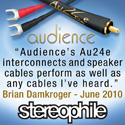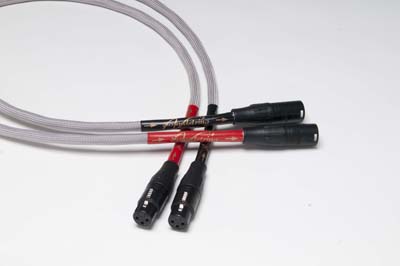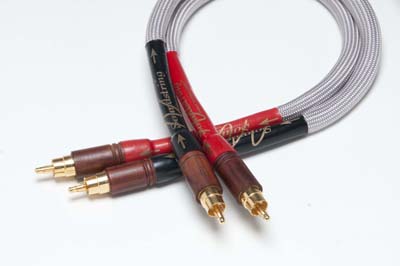|
|
You are reading the older HTML site
Positive Feedback ISSUE 61
soundstring Generation II Platinum Series Cables: Wake Up and Hear What "Audio Value" Means as reviewed by Jim Merod
You Remember This… The kid on your cub scout softball team or maybe in your neighborhood basketball league who always plucked the duck—the goofy dork wad guy who dropped fly balls in the outfield and fluffed every open layup. We called that spastic dope a "Mufty" since he muffed everything he touched. Have you noticed how, now grown up, those anxious characters are still with you everywhere you go? Sometimes they're an office mate or the mortgage loan officer you depend on for your refi. It's true: Mufties never go away. They morph with age into Woody Allen without humor, skulking along quietly waiting to spill coffee on your new suit or maybe drop luggage from the overhead bin on your innocent noggin. No shortage of Mufties anywhere. Try this, then. You're ready to upgrade your home theatre system and do your research fairly well. You've got a new amplifier and DAC, maybe new speakers, too. Now it's time to tie it all together. Some big-shot audio reviewer encourages you to pop significant dough on Bloomdido Extra-Fractalizng Realization Cables at something akin to $7999 per meter. Your refi was approved. You've pulled a chunk out to enhance your system. The Extra-Fractal hot rod wires are now yours, beautifully installed between amp and speakers, another set oozing from the Dromgurgle Bazooka DAC right into your state-of-the-art Holographic Mastercraft gold plated preamp. Hooray. Time to boogie. The only problem here is that several weeks into expected, uninterrupted and thoroughly enlarged sonic joy you find that your favorite music seems somehow stiff, duly kilter and not at all what you thought you were hearing initially. Worse than that, your sound and your music are not as engaging as your much earlier set up with Radio Shack ten-gauge wire right off the shelf. What to Do? First thing, pal, you might stroll into the bathroom and look at the goon in the mirror. That guy fell for a "mufty." That goofy face staring at you houses a lifelong habit of tolerance for, and victimage by, the kid who lost at least half of those childhood contests you wanted to snag. And there, right now in your hometown, on your street, in your living room home theater system, a mufti audio jerk-off robbed your bank by seducing your gullibility. You're now the irked owner of expensive lamp cord. Hey, bozo! Wake up, okay? It's only money down the drain. You still have beer in the 'frig. Second, any committed audio devotee has to think on several levels at once. Immediately, how much can you really waste… I mean invest in this hobby? Donald Trampoline, the famous New York high rise condo impresario ("Big Don") has enough moolah that cost is utterly irrelevant. But you just refi'd your pad and all that money thrown at ongoing audio and musical pleasure surely deserves an appropriate rate of return. What've you got there, Harvey? Exactly what percent is your audio/expense ratio? So here we encounter that age old issue. What's your first move at auto reconstruction? After you figure out a prudent audio budget, where do you begin the trek to nightly musical nirvana? Speakers? But how can any set of transducers lift your spirit unless signals delivered there are, in a word, accurate-with-musical-textures (hyphenated constructions counts as single terms)... so, maybe after all, you should start with big rig mono-blocks, right? And there's always the "heart of the heart" problem: the core unit where it all flows through, your plug in and out junction box. So you begin by plopping big bucks on the much ballyhooed preamplifier from Deutche Profundus Maximus. You are absolutely sure THIS IS THE ONE to build your sonic rig around forever onward. Music forever! Etcetera and so forth. It's an endless dilemma, really. There is no right place to start. And there's no obvious fine-tuned budget that can save you from undershooting your audio goal or to protect you from enthusiastic excess. Therefore, here it is: start anywhere, but do your homework. Consider audio gear as an investment, not a game of revolving sonic perversity. Why not begin with very good cables? If you do that, you'll have a view into what your gear is doing (and what it's not accomplishing, as well). If you want to meet a sonic standard, you need to know what you have already, in some detail, along with what precisely more or less you're looking for. It is all about what you want to hear. In a commercial universe of massive audio illiteracy, does a guy or gal have an honest chance at success here? My suggestion is that you think of a serious cable upgrade as an investment not only in present moments of musical joy, but as an ongoing boon (if you choose the right wire) because—if you garner mega-bucks later on and "invest" in potentially more musically accurate and seductive cables—then your current wire goes into an office or bedroom system. Voila! No need to dump genuinely good cables if you've invested well. Singing Strings Four or five years ago I came across Len Miller's honorific cable company just as it was gearing up to enter the audiophile market. Len, who runs his operation with tender loving glee a bit like Ahab, returned from long years at sea, saved from sharks on the same raft with his buddy, Ishmael. Counter-intuitive, but what a ride… what obviously no-BS results! In my first conversation with this optimistic yachtsman, he noted that he had his sights set on joining the "inner circle" of ultra-high end cable manufacturers (whatever that elite gaggle of artisan craft crafters might be). Did I have recommendations regarding several of those? Maybe I did and maybe I didn't, I replied, but precisely what sort of Quixotic dream leads a perfectly reputable and successful wire company into such choppy waters, I wondered aloud. Years of experience across the cable industry, I was told, convinced Len Miller that the best wire products were a combination of the best materials assembled with the enigmatic subtlety of cabledom's exotic art. Somewhere along the way, Soundstring's gang found significantly upgraded materials as well as the artistry and craftsmanship needed for the leap up and forward. The result, awhile back, was their remarkable and highly successful series of GEN I cables that pushed the price of high end cables down toward real world audio budgets while, simultaneously, raising the performance value of superior yet affordable cables. That achievement—a gift for audiophiles tired of their own (and audio sales folks') "mufti" proclivities—has recently been topped with Soundstring's upgraded GEN II series.
Never a company devoted to cosmetic flash and glitter, the "no nonsense" hard hat plain good looks of the Gen I's brownish-umber cloth sheathing has been replaced with vivid silver grey cloth wrapping in the new series. The enhancement is not superficial. Gen. II wires carry a clearly faster signal transmission with discernibly more open and relaxed sonic output. There's more "there" in their seductive musicality. It's as if a wonderfully appealing audio reality became operatic, a voice with deeper lows and more resonant highs, a fuller sense of ambience and micro-decay with transients such as the more delicate and well-defined sonic tail from brushes on high hat cymbals. Nothing is exaggerated or left loose and unstated in the GEN II wire. I've previously commented at length on the balanced GEN II cables that serve my world with equal friendship both as interconnects in an audio system at home as well as in the role of microphone cables in the field for live recordings. The simple truth is that the majority of my routine recording calendar is accomplished with a squad of Soundstring GEN II balanced cables of various lengths, from one meter to fifteen meters. Are there better cables I could employ? Yes, but none within near reach of the Gen II series at anything close to its price. Do I use more expensive cables when it suits me, or when it seems imperative? Yes, but my point here is—in a cable universe that offers mega-expensive wire: Nordost, Siltech, Stealth, Kubala-Sosna, Shunyata, Acoustic Zen—for what is in fact truly a "discount" one gets a high percentage of genuine audio glory with GEN II wires. What About the Other Mufty Factor? I mean here the simple issue: do the Gen IIs stand up all along the line? Are the speaker cables a similarly benign value as that offered by their balanced cables? Do GEN II power cords exist within the orbit of enhancement and value clearly demonstrated by their XLRs? Simply put, the answer is yes... but what's interesting here is that, while each of the sonic outcomes in the GEN I series are pretty much alike and uniform across that series—i.e., power cords and speaker cables delivering sonic finesse of the same sort one finds in the balanced and unbalanced cables—I've come across intriguing distinctions among the GEN II series. None of these differences is annoying or debilitating. Not a single deviation from "sameness" is dissimilar by a desultory margin. On the contrary, unlike what I experienced years ago when I did a fairly lengthy shoot out among many iterations of Wire World cables (when that series exhibited a marked similarity-with-increased-degrees of resolution in their incrementally upgraded cable steps), distinctions among GEN II cables demonstrate unique and uniquely viable sonic attributes appropriate to each function. To wit: the GEN II speaker cables (unlike many elsewhere) do not display a fall off in resolution when you swap an extremely long twelve meter set into a system, replacing (say) a two or three meter pair. That achievement on occasion has been touted by speaker cable manufacturers. In my experience it is rare. Only Kubala-Sosna's Elation! and Emotion (as well, amazingly, as their truly value-oriented Studio Reference) cables have shown me this happy and somewhat counter-intuitive result. The GEN II series, as a whole, has a beautifully-resolving quality from the top to the bottom of the spectrum. However, the sonic element that's impressed me most is the neutrality they produce in each configuration… a seeming refusal to go for added "presence" or dynamic slam or any of a number of other (not so subtle) sonic emphases that even high priced wire on occasion lapses toward. I suppose the best way to put all this is to say that I'm never disappointed with the musical outcome of these cables no matter how or where I employ their signal delivery. GEN II cables are a little bit like a tried and true friend who always brings a smile to your life regardless of weather, season, stress or financial conditions. Don't we all love such friendship if we're fortunate to have it? And isn't such an unannounced, totally supportive blessing, against the grain of life's vagaries and stupidities, an essentially unearned (or never fully paid) gift that makes all the difference on some days… and maybe, in the final assessment, in the full run of our days? Do I have better cables than the GEN IIs? Yup, but do I have any gripe or discontent with these wires? NOPE, not a single one. Variations of the GEN II Theme Let me get back to the intriguing matter of these cables' interesting distinctions among themselves, which may not be fully "normal" (whatever the hell that really is). Put bluntly, the (new to me) GEN II unbalanced cables are frankly kick ass wires that, broken in with large numbers of hours on an audioharma cable cooker at the factory, come roaring out of the box (literally) to underscore nuances of tone, register and dynamic shading often lost or swallowed in signal travel. Now I must indicate here that, with the RCA and XLR versions of GEN IIs I have frequently felt, as it were, "inside" these wires—listening to my own recordings like an obsessed parent with various headphones: several Senheisser 'phones; AKG 1000s and Grado Twos; Ultrasone Platinum and Audio-Technica K-701s as well as Etymotic ear buds. Gen II's essential sonic trait is full-range audio relaxation, a sense of "real world" ambient truth made vivid with relaxed immediacy. I need to add here a quick note that the unshelled version of these cables, for me (to my eager ears), seem more "open" and sonically free, as if the music in motion is flying, much as one finds hawks or eagles who float effortlessly at heights without effort. Now the Gen. II power cords may be the most intriguing cables in this line. Their standard high-output power cord, which ranks alongside any truly high-end power cord I know of with very few exceptions, is augmented by a low-output "platinum series/digimax-18" rated for 10 amps. Employed as designed—with a phono stage or small output digital front end unit—these cables are quite possibly the class of a truly classy series. Its three conductors each have168 strands of #40 gauge six-nines oxygen-free bare copper (high conductivity). Gear driven by these power cables seems quicker, lighter and freer in its immediacy and sonic impact. I'll be surprised if anyone getting one or more of these unusually well-crafted cables in a system is not stunned by the sonic result. In sum, GEN II unbalanced cables are, in my estimation, one of the great values in high end audio gear. The power cords are way better than merely "fairly priced" and the balanced cables along with the speaker cables leave nothing to be desired once they are settled in and do their job or making lyrical reality convincing in a good sound system. I have no difficulty believing that, for the majority of home theater set ups and for the bulk of music lovers who care first and last about how their music defines free hours of listening, Soundstring's GEN II series will be all they want and need to feel graced each and every time they turn their equipment on. There are inevitably degrees of better and best in each inch of the High End Quest. For the cost involved in making music that is whole and real—enchanting as well as discerning—Soundstring's new series amounts to Christmas for adults or the Easter Bunny's springtime visit to very good older boys and girls who love Pavarotti and Miles no less than Elvis, Frank, Fogerty and Streisand. Throw in Billie Holiday and maybe Beethoven's Seventh and you have a universe of sound to lull you into the waking Land of Nod. Mufty Basher’s Unite My boyhood pal, Jimmy Achimakopolis, was a gem. We called him Jim-Jim. After a few blown steal signs and muffed tosses, he became Dim-dim, Later it was simply Dimmer (as in dim-wit). He was not made up to be an athlete. I remember him fondly as a good guy who lost his drift. Or drifted off in permanent dozing. A human daydream perpetually nodding. Not all mufties are as charming as Dimmer was. From his initial example onward, I've kept an eye cocked toward the next mufty ready to sell me insurance or rebuild my portfolio. Choose your poison carefully. With these GEN II cables I've discovered poison's antidote. If you're "The Big Don" in a lofty Manhattan tower, throw mega-bucks at your gear. Otherwise, choose your audio poison with care. Soundstring's new cable line may make your investment feel like a sonic portfolio on the rise. Jim Merod
"SE" Special Edition Gamma 4-12 High
Out-put (cable rated for 30 Amps) Power Cords with Furutech 120V-15 Amp
Male and IEC-C13 Female Plugs Interconnect Cables (single ended with our patented "Ultra Low Mass" RCA plugs all ends):
Beta 2-22NS (Non-shielded and single
ended) pairs with RCA's:
Beta 2-22S (Shielded and single ended)
pairs with RCA's: Interconnect Cables (shielded & balanced with Neutrik XLR's all ends):
Beta 2-22S (shielded and balanced) pairs
with XLR's:
Soundstring Cable Technologies, LLC
|










